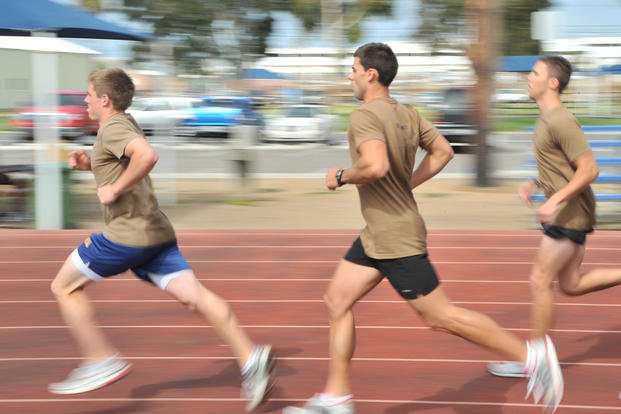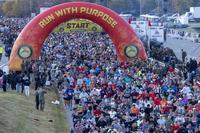Workouts to improve your fitness test timed runs (1.5, two or three miles) are plentiful, and while some may work great for you, others may not.
There is no running plan that works best for everybody. As with a diet, we are all different, come from different training backgrounds, have different issues with bone and soft-tissue pain and have different stride lengths.
What follows are a few of my favorite running plans.
Run and Leg PT
This one is my favorite go-to run and leg workout when I am trying to drop mile pace significantly for premium fitness test scores. There are two things you need to work well when you are running faster for medium or longer distances -- your lungs and your legs. This works as a two-for-one deal for a leg day during a running cycle.
I am not a fan of lifting heavy with your legs while trying to drop your mile pace. Sure, you may be able to hit the minimum standards on a run, and some can do well with lifting legs and running fast, but I was never one of those people. When I lift legs heavy and get stronger one-rep maxes (1RM) in squats and deadlifts, I gain weight.
That makes me slower with my mile pace but faster with sprints. Here are two leg calisthenics (non-weighted) and running workouts that focus on both faster pace runs and sprints to push the lungs:
Repeat 6-8 times.
- Quarter-mile at near sprint pace
- Rest with 20 squats & 10 lunges/leg
Repeat 6-8 times.
- Quarter-mile at goal mile pace
- Rest with 20 squats & 10 lunges/leg
I like to do this one at least two days a week in place of leg days in the weight room. If your workout during the week has you running big hills, you can replace the quarter-miles with steep hills or skip the leg PT and just do big hills for your run and leg day.
Run Hills
Running long, fairly steep hills has been a group "favorite" for the past few years. We noticed many of the local cross country teams train on about a 40-degree hill that is about a quarter-mile long. Repeating the hill 5-10 times by sprinting or running up and easy jogging or walking down has helped countless members of our group crush running tests -- many in the sub six-minute pace. This is above average in military and even special-ops circles, especially for 200+-pound, non-running athletes.
Fartlek
If you know running, you have used this term. It is Swedish for "speed play." A Fartlek workout is a fast-paced run, followed by an easy paced recovery distance or time. For example, most people like to run fast for 1-2 minutes at or faster than goal pace. Then take the same amount of time or less to recover. You do these types of interval (fast/slow) runs for a particular distance or time.
Interval Runs with Goal Pace
If you are running an eight-minute mile and want to drop that to a seven-minute mile, you have to get used to running faster and learn your new pace. We do that with intervals at your goal pace and recovery jogs or walks. Here is a good goal-pace workout for any distance. However, the longer your test for an event, the more sets you will want to do with this to at least match the test distance:
Repeat 6-12 times (for prep of 1.5 to three-mile runs).
- Run quarter-mile at new goal pace (1:45 for seven-minute mile)
- Walk or jog an eighth of a mile recovery pace
Repeat 3-6 times.
- Run half-mile at new goal pace (3:30 for seven-minute mile)
- Walk or jog quarter-mile recovery pace
Get Specific with Your PFT
There is nothing wrong with adding all of the elements of your PT test before you run, as that is how you will be doing it on "game day." Everyone runs faster when they have not done other events like swim, push-ups, sit-ups or pull-ups. Most of that is due to not transitioning to the run like a triathlete transitions to the next event. If your PT test does not have other events before it, then I would not worry. The goal here is to mimic how you will feel after you have done the previous part of the test.
Sprint/Pace Combo Pyramid
A challenging running workout requires you to repeat your quarter-miles at a faster pace each set. Here is a running workout that will push you to your complete max effort:
Running pace pyramid: quarter-mile or 400-meter repeats
- Run quarter-mile at two minutes
- Run quarter-mile at 1:50
- Run quarter-mile at 1:40
- Run quarter-mile at 1:30
- Run quarter-mile at 1:20
- Run quarter-mile at 1:10
- Run quarter-mile at 60 seconds or less
* rest for 1 minute each set
If you can handle it, repeat in reverse order.
Mile Repeats
Running one mile over and over again is a tough workout, especially if you can match your goal pace each set or even try to push yourself and get your fastest mile ever attempted. As you progress and quarter-mile and half-mile run intervals are getting easier, this is the next progression to push your goal pace at longer distances.
Playing Sports
Depending upon the sport you play and how often, you can stay in good enough shape to max and score well above the minimum standards on military fitness tests. Soccer, basketball, lacrosse and even some martial arts programs are tough enough to keep you in passing running shape for 1.5- to three-mile timed runs.
Not Running
If you are susceptible to running injuries, you can stay in cardiovascular shape and keep your legs strong and durable in the gym. Doing cardio machines and workouts like elliptical intervals, bike pyramids, rowing, and swimming can keep the lungs and legs in shape to pass a biannual fitness test. Depending on your intensity and volume per week, you might be able to push maximum levels, too.
Schools of Thought
There are a few schools of thought about the methods to become a faster runner. Some are as simple as getting out and running more. Some are more into sprint intervals. Some are more into running longer distance runs like cross country to make timed runs easier. Some even recommend playing sports year-round to stay in shape so that running timed runs is never an issue of not passing.
Whether you are looking for a plan to help you just reach the minimum standard, or you want to crush the maximum score possible, there is a plan for you out there. Perhaps one of these will help you. Give them a try or create a week of a few favorites and add some variety to long, slow, distance runs every day.
Stew Smith is a former Navy SEAL and fitness author certified as a Strength and Conditioning Specialist (CSCS) with the National Strength and Conditioning Association. Visit his Fitness eBook store if you're looking to start a workout program to create a healthy lifestyle. Send your fitness questions to stew@stewsmith.com.
Want to Learn More About Military Life?
Whether you're thinking of joining the military, looking for fitness and basic training tips, or keeping up with military life and benefits, Military.com has you covered. Subscribe to Military.com to have military news, updates and resources delivered directly to your inbox.



















